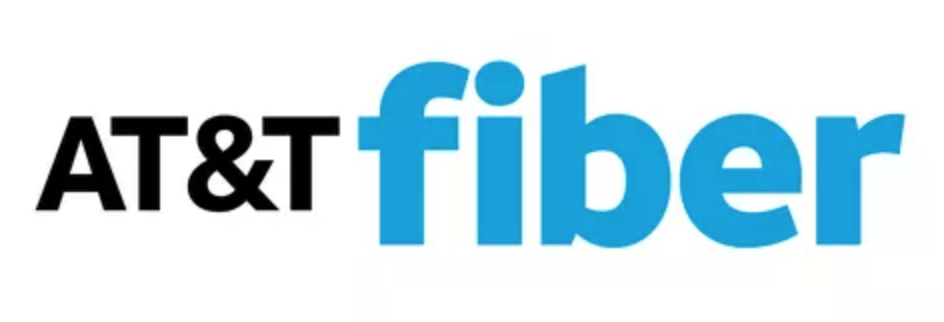Since AT&T updated their internet-only pricing in late 20201, their fiber internet service is now available in five plan tiers by speed. The three entry tiers are 300, 500, and 1,000 Mbps. Some areas also have access to expanded gigabit plans, offered at 2,000 Mbps and 5,000 Mbps tiers.
The pricing on these plans ranges from $55–250 per month. While the price range is similar to cable providers like Spectrum or Xfinity, the speeds offered by AT&T Fiber are several times faster — particularly when it comes to uploads.
Here’s a top-level summary of speed and pricing for all current AT&T Fiber internet plans. I’ll dig into the fees, fine print, and TV options below.
| Plan Name | Advertised speed | First Year Price | Final Price |
|---|---|---|---|
| Fiber Internet 300 | 300 Mbps | $55/mo | $55 |
| Fiber Internet 500 | 500 Mbps | $65/mo | $65 |
| Fiber Internet 1000 | 1000 Mbps | $80/mo | $80 |
| Fiber Internet 2000 | 2000 Mbps | $125/mo | $150 |
| Fiber Internet 5000 | 5000 Mbps | $225/mo | $250 |
Which AT&T Fiber Internet Plan is Best?
The 1,000+ Mbps plans are fun if you can afford them, but 90% of customers won’t notice the difference between 300 and 1,000 Mbps in daily use. With that in mind, I suggest:
- 2–3 users in small home or apartment: AT&T Fiber 300 Plan.
- 3–5 users in single family home: AT&T Fiber 500 Plan.
- Power users, home office, large family: AT&T Fiber 1,000 Gigabit Plan or higher.
Going with the 300 or 500 plan tiers will save you as $360-600 over the first two years of service compared with the top-tier Gigabit plan, accounting for differences in promo pricing and equipment fees.
Order Online Order by Phone: (833) 438-1016Pros and Cons of AT&T Fiber Internet
There are two factors that make AT&T Fiber worth considering as an alternative to cable:
- Upload speeds: AT&T Fiber upload speeds match their download speeds, which results in upload performance almost 150 times better than cable. (Not a typo. Cable uploads are still very slow due to constraints on coaxial cable lines.)
- Reliability: Fiber internet is delivered on fiber-optic lines, which are more reliable than cable and less prone to slowdowns during peak use times.
However, AT&T Fiber does come with some drawbacks:
- Premium sports options: Cable companies still have the edge when it comes to premium sports access. It’s likely AT&T will add NFL Sunday Ticket to AT&T internet/TV bundles in the future, but for now it’s exclusively licensed with their satellite service.2
- Equipment limitations: While competitors like Spectrum and Xfinity will allow you to use your own modem and router, AT&T requires you to use their equipment on all plans. The only way around it is to put their router in “bridge mode” and connect yours on top of it. Thankfully, they’ve stopped charging leasing fees on routers in recent years, likely in response to new legislation targeting the practice.
Important distinction: AT&T Fiber vs AT&T DSL/IPBB Internet
Shopping for AT&T internet can be confusing because they operate two different networks: an older DSL network, and a newer fiber-optic network.
If you’re in an AT&T DSL service area rather than an AT&T Fiber service area, you are almost certainly better off with cable due to the lower speeds and data caps on AT&T DSL.
You can check if your address is in a Fiber or DSL area at the AT&T website. Note that the DSL plans will be described as “IPBB” or “High-speed internet,” or even “hybrid-fiber,” which can be confusing for non-techies. In short, if the top speed is 5–100 Mbps and they only list one plan, it means they haven’t built fiber in your neighborhood yet.
AT&T Fiber Speeds: are they good?
Let’s start with the speeds on offer, since they are the main area where AT&T Fiber is different from basic cable or wireless.
As mentioned above, AT&T Fiber service is symmetrical, so you will see very high upload speeds relative to cable. While the highest cable plan upload speeds from Xfinity, Spectrum, and Cox cap out at 35 Mbps, AT&T Fiber’s lowest upload speed is 300 Mbps. On the high end, they go up to 840 Mbps for the top-tier Gigabit plan.
Note that while the Gigabit plan is advertised as “1,000 Mbps,” you’ll likely see about 940 Mbps download and 840 Mbps at peak performance, with speed tests over WiFi likely to be closer to 600/500. This is due mostly to limits on ethernet cables commonly used in home wiring, not actually an issue with the bandwidth supplied by AT&T.
Some speed variation due to nearby customer use is also possible, because the technology (GPON) used to deliver service, which is shared between locations to bring down the price. Areas upgraded to XGS-PON for the 2+ Gbps plans typically won’t see this issue.
Regardless, fiber lines have very high data capacity compared with cable — so even when “shared,” you won’t experience noticeable slowdowns in the evening as is common with cable.
As for the gig speeds: unless you’re running a massive call center out of your basement, you’re very unlikely to notice the difference between 940 and 1,000 Mbps service.
AT&T Fiber as a cable internet alternative
Here’s how the internet-only base plans compare between AT&T and their main competitors:
| Provider | Service type | Entry speed | Entry price | WiFi Fee |
|---|---|---|---|---|
| AT&T | Fiber | 300 (plans up to 940 Mbps) | $55+ | $0 |
| Spectrum | Cable | 300 (plans up to 1,000) | $49.99+ | $7 |
| Xfinity | Cable | 75 (plans up to 2,000) | $19.99+ | $15 |
| Cox | Cable | 10 (plans up to 940) | $29.99+ | $10.99 |
TV is a bit more complex, since the mix-and-match nature of the services and myriad local and licensing fees makes it hard to promise a specific price.
Is the Price of AT&T Fiber Worth It?
AT&T Fiber internet is worth the price for long-term customers since it’s actually cheaper than cable plans in the same speed tier. Cable companies will almost always have a lower rate for the first year, which increases in the second. AT&T does not currently play this game, which makes the price look “expensive” up front. However, the final price is typically lower than cable.
AT&T TV options vs Cable bundle alternatives
AT&T owns and operates a number of TV services, ranging from DirecTV satellite service to streaming services like HBO Now.
Their primary TV product is called DIRECTV STREAM (formerly “AT&T TV”).
All their TV products has two big problems, which aren’t deal-breakers for everyone, but are important to understand before signing up:
- A two-year contract is required for free device deals advertised.
- Even with the contract, your price will go up around $10 after the first 3 months or so.
Now, at the surface, DIRECTV STREAM pricing looks reasonable for what you get. The channel lineup is sort of a hybrid between traditional cable bundles and YouTube TV; it comes with a slim DVR-type device that goes on top of your TV, and delivers streamed content in a traditional channel-surfing package.
As with most TV products, the price goes up after the trial period, which is three months at the time of this writing. The price has also gone up more than once due to increasing content costs since the product launched.
While the value is no better or worse than other skinny bundle providers like FuboTV, this could change if AT&T brings NFL Sunday Ticket to the table, since let’s be real; if you’re looking at TV bundles, you’re probably doing it for the sports lineup.
I’ll update this post if it happens, but for now it’s still not clear if DirecTV will be sold off or not, and in either case, who will take on the Sunday Ticket rights and under what conditions.
For now, the main benefit of DIRECTV STREAM is that they have extensive sports programming, including regional sports networks like Fox. They’re the only streaming platform with those rights currently, so it makes sense as an alternative to going with a cable TV company — but not so much as an alternative to Hulu or Netflix, in my opinion.
Is AT&T Fiber available for low-income households?
AT&T has a low-income plan called AT&T Access 10, which provides discounted service for homes that participate in qualifying public assistance programs such as food stamps or school lunches. AT&T does not offer senior, veteran, or military discounts, so this is the only way to get a notable discount on internet-only service.
If you qualify for AT&T’s low-income discount offering, you will get it over fiber lines if you are in a fiber service area. However, the speed will be throttled to meet the maximum standards shown below for the plan, which are extremely low compared with the standard rate consumer plan.
It’s also worth noting that AT&T Fiber is primarily available in higher-income neighborhoods, given that there is more incentive to build in those locations to maximize yield from the network investment. 3 It’s therefore unlikely that there’s Fiber-to-the-Home service at your building, if you’re in a lower-rent neighborhood.
| Plan Name | Speed Down/Up | Monthly Price | WiFi Fee |
|---|---|---|---|
| AT&T Access 10 | 10/Variable Mbps | $10/mo | $0/mo |
-
https://www.fiercetelecom.com/telecom/at-t-fiber-debuts-new-pricing-across-three-tiers-offers-unlimited-data-for-fiber-customers ↩
-
https://variety.com/2020/digital/news/att-restrictions-streaming-nfl-sunday-ticket-streaming-2020-season-1234735708/ ↩
-
https://cwa-union.org/sites/default/files/20201005attdigitalredlining.pdf ↩
Frequently Asked Questions
Does AT&T Fiber internet have data caps?
AT&T does not place data caps on their fiber-to-the-Home internet plans, including the 300 mbps base tier plan. AT&T Fiber plans have unlimited data use. The company does have caps on their IPBB or DSL plans, although caps can be removed for an additional fee of around $30 per month.
Is AT&T fiber good for gaming?
AT&T Fiber is a good choice for gaming because it offers bandwidth up and down of at least 300 Mbps on all plans, meaning that you’ll have no issue streaming from a provider like Stadia or streaming live to a platform like Twitch. The bandwidth on all AT&T Fiber plans is sufficient for 4K definition video over WiFi, and the pure fiber connection produces lower ping measurements relative to cable or DSL. You can expect ping to be 20–30ms lower since the network is newer and will have newer switching equipment at all hops between your home and the server.





